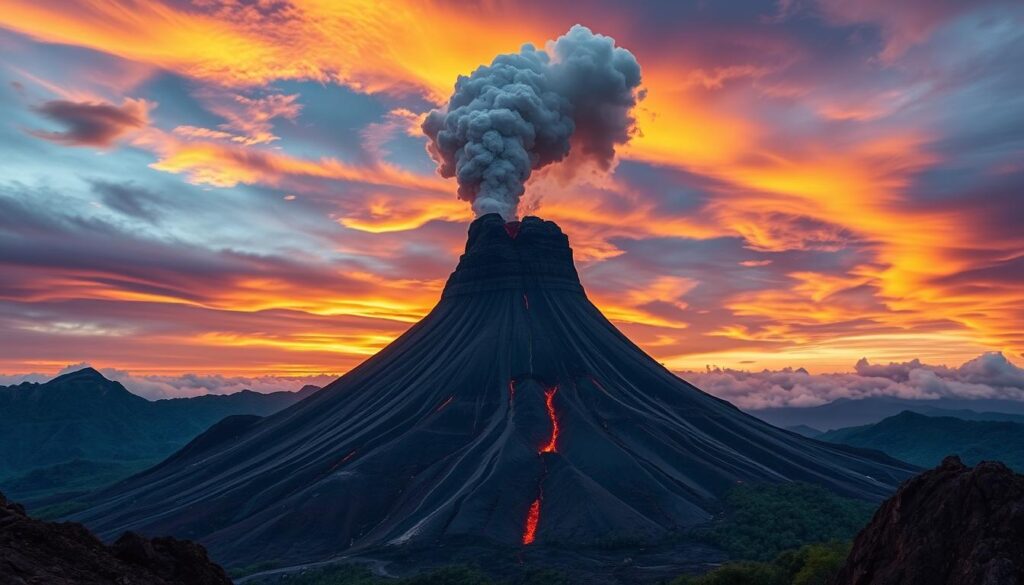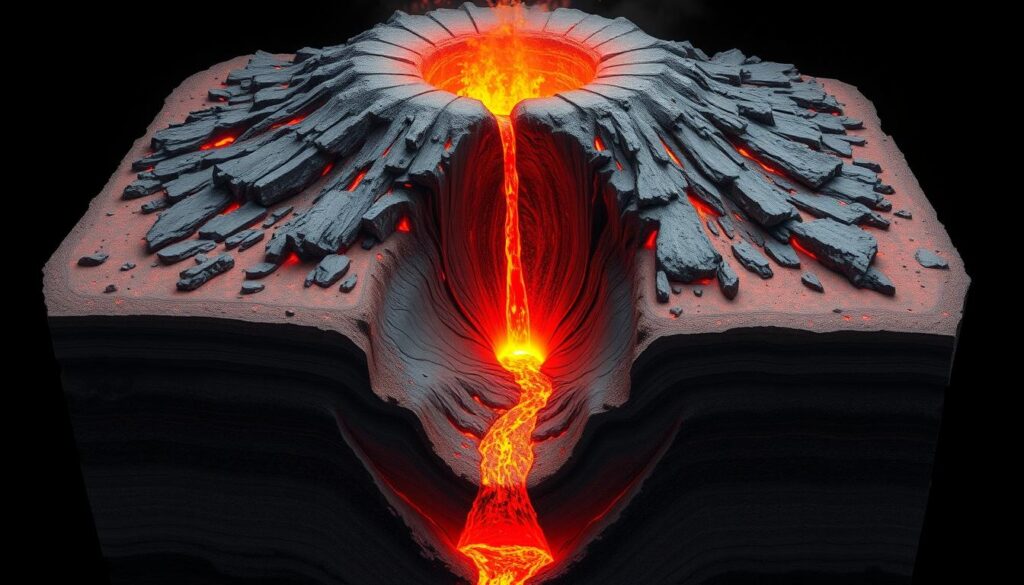
A majestic composite volcano towering against a vibrant sunset, showcasing multiple layers of hardened lava and ash, with a plume of smoke and ash rising from its summit, surrounded by lush green forests and rocky terrain, under a dramatic sky filled with swirling clouds and hints of orange and purple hues.
Composite volcanoes, or stratovolcanoes, are towering wonders that amaze us all. They stand high, with steep sides and a symmetrical shape. These mountains grow as they collect hardened lava, tephra, pumice, and ash.
At their core, a complex system carries magma from deep inside the earth to the surface. This process fuels eruptions that have reshaped our landscapes for millions of years.
As these volcanoes grow, they add layer after layer of erupted material. This creates a unique and striking geological feature. People from all walks of life have been fascinated by these mountains for centuries.
From Mount Fuji in Japan to Mount Rainier in the United States, these volcanoes show the incredible power of our planet. They remind us of the dynamic forces at work beneath our feet.
Key Takeaways
- Composite volcanoes, also known as stratovolcanoes, are cone-shaped mountains formed by layers of hardened lava, tephra, pumice, and volcanic ash.
- These volcanoes are characterized by their steep, symmetrical sides and large dimensions.
- The essential feature of a composite volcano is a conduit system that allows magma from deep within the earth’s crust to rise to the surface.
- The volcano’s size increases as material erupted through the conduit, such as lava, cinders, and ash, is added to its structure.
- Composite volcanoes are found in various regions around the world, including the Pacific Ring of Fire, and have played a significant role in shaping the Earth’s landscapes.
Unveiling the Majestic Composite Volcano
Composite volcanoes are towering marvels of nature. They have a distinctive conical shape and impressive dimensions. These volcanic giants are built up over time through the accumulation of various volcanic materials. This creates a captivating layered structure that showcases the raw power and dynamism of our planet’s geological processes.
A Towering Marvel of Nature
Composite volcanoes, also known as stratovolcanoes, are tall, steep-sided, and symmetrical. They can reach astonishing heights, with some over 20,000 feet (6,000 meters) above sea level. The volcano’s dimensions and symmetry show the intricate interplay of forces that shape these natural wonders.
The Building Blocks: Layers of Lava and Ash
The defining feature of a composite volcano is its layered structure. This is created by the accumulation of hardened lava, tephra (fragmented volcanic material), pumice, and volcanic ash. These materials are erupted through the volcano’s central conduit system and gradually build up over time. This forms the characteristic volcano slope and cone shape.
| Volcanic Material | Description |
|---|---|
| Lava | Molten rock that flows out of the volcano’s vent or erupts explosively. |
| Tephra | Fragmented volcanic material, including ash, cinders, and larger rock fragments. |
| Pumice | A lightweight, porous volcanic rock formed by the rapid cooling of lava. |
| Volcanic Ash | Fine, powdery material ejected during explosive volcanic eruptions. |
The composite volcano structure is a testament to the dynamic interplay of these volcanic materials. It creates a visually captivating and geologically complex natural formation.
“Composite volcanoes are like the architectural masterpieces of the natural world, built layer by layer through the relentless forces of nature.”
The Anatomy of a Composite Volcano

“An intricately detailed cross-section of a composite volcano, showcasing the volcanic conduit at its center, surrounded by layers of magma, rock, and ash. The conduit should be depicted as a narrow, winding channel filled with molten lava, leading to a prominent crater. Vibrant colors of glowing lava contrasting with dark volcanic rock textures. Include geological features like fissures and sediment layers in the surrounding earth.”
At the heart of a composite volcano is a complex system. It connects a deep magma reservoir to the surface. This volcano conduit is key, letting magma rise and erupt. It helps the volcano grow and change over time.
The Conduit System: A Pathway to the Surface
The conduit system of a composite volcano is complex. It has many layers that help magma move from deep down to the surface. This system is behind the volcanic eruptions that shape the volcano structure over time.
The main parts of the conduit system are:
- A deep magma reservoir, where molten rock builds up pressure
- A vertical conduit, where magma rises to the surface
- A complex network of smaller feeder dikes and sills
- A crater or vent at the summit, where magma is expelled
As magma moves up, it can mix with groundwater. This can lead to explosive volcanic eruptions. It also helps build the volcano’s conical shape.
“The conduit system is the backbone of a composite volcano, channeling the powerful forces of the Earth’s interior to the surface in a dramatic display of nature’s might.”
Knowing about the volcano conduit system is key. It helps predict and manage risks from composite volcanoes. It also shows us the amazing geological processes that create these natural wonders.
Composite Volcano: Nature’s Architectural Masterpiece
Composite volcanoes are more than just rocks; they are nature’s architectural wonders. These towering mountains rise from the earth, their conical shapes and steep sides awe us. They are built layer by layer of hardened lava, tephra, pumice, and ash, showing the earth’s inner power.
These volcanoes greatly affect the environment around them. They can change the local weather and pose dangers like eruptions. Yet, they also draw people in, becoming famous spots that show the earth’s beauty and power.
Mount Fuji in Japan and Mount Rainier in the U.S. are examples of these volcanoes. They remind us of the earth’s dynamic forces. Their presence shows the balance between the earth’s surface and its fiery core, a balance that has fascinated us for centuries.
Important Point
| NO. | Important Points |
| 1. | About Us |
| 2. | Contact Us |
| 3. | Disclaimer |
| 4. | Privacy Policy |
FAQs of Composite Volcano
What is a composite volcano?
A composite volcano, also known as a stratovolcano, is a tall, cone-shaped mountain. It’s made of hardened lava, tephra, pumice, and volcanic ash. These volcanoes have steep, symmetrical slopes and can grow very tall.
How are composite volcanoes formed?
Composite volcanoes grow over time with layers of different materials. These include hardened lava, tephra, pumice, and volcanic ash. Each layer adds to the volcano’s height.
What is the role of the conduit system in a composite volcano?
At the heart of a composite volcano is a complex conduit system. It connects a deep magma reservoir to the surface. This conduit allows magma to rise and erupt, helping the volcano grow.
How do composite volcanoes impact the environment and human civilization?
Composite volcanoes greatly affect the environment and human life. They can change the landscape and influence weather. They also pose risks like eruptions and natural disasters. Yet, they inspire awe and attract tourists, showing their beauty and power.
What are some examples of famous composite volcanoes?
Famous composite volcanoes include Mount Fuji in Japan, Mount Rainier in the United States, and Mount Merapi in Indonesia. These mountains are natural wonders and hold cultural and historical value.
How do composite volcanoes differ from other types of volcanoes?
Composite volcanoes stand out from other volcanoes like shield volcanoes and cinder cone volcanoes. Shield volcanoes have broad, gentle slopes. Cinder cone volcanoes are small and steep.
What are the potential hazards associated with composite volcanoes?
Composite volcanoes can be dangerous. They can have explosive eruptions, lava flows, ash falls, pyroclastic flows, and lahars. These disasters can harm communities and infrastructure, so it’s important to watch for volcanic activity.
